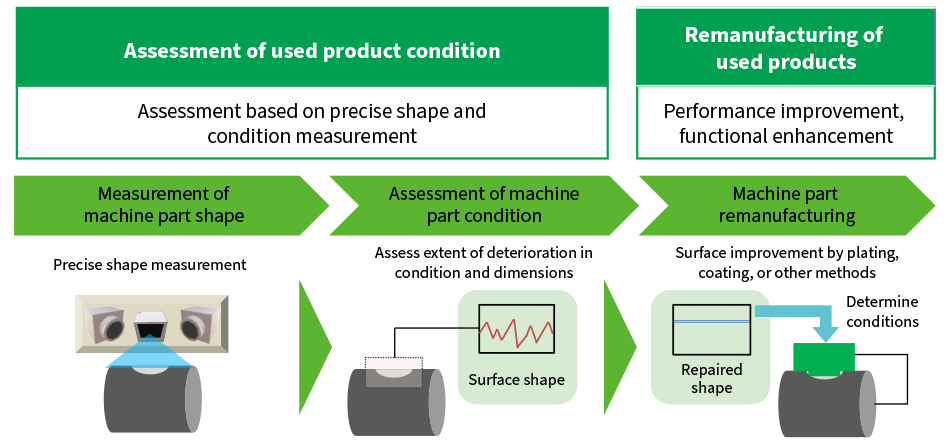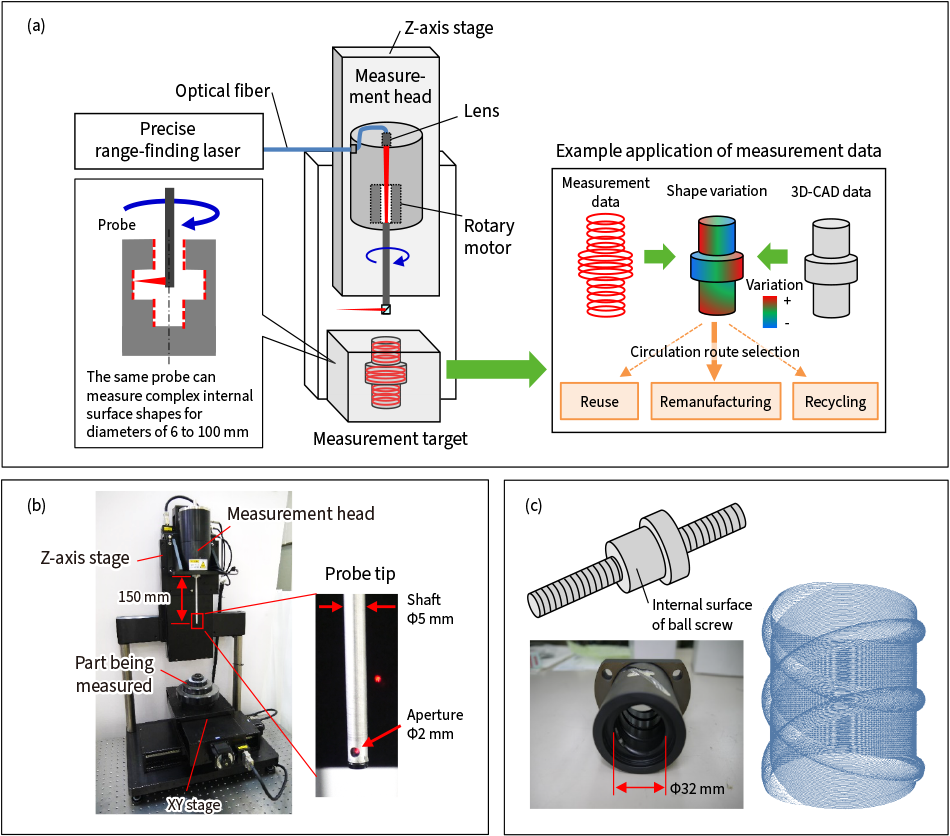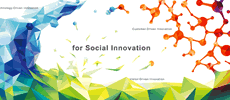Development of Smart Remanufacturing Solution for Upcycling of Used Products
Highlight
Amid the emergence of global-scale environmental problems, manufacturing is making a transition to a circular economy as part of its efforts to reduce the load on the environment. As current recycling and reuse practices for industrial products diminish economic value, upcycling has attracted attention as a means of simultaneously reducing the load on the environment and enhancing economic value.
Hitachi is currently developing a smart circulating solution for putting upcycling into practice. The solution comprises a technique for the highly accurate assessment of the condition of parts that directly affect the performance of used products and a surface improvement technique that applies gel-electroplating to improve the functionality and performance of these parts. This article reports on development progress and plans for the future.
1. Introduction
Planetary boundaries have come to be recognized as an objective indicator for assessing the influence that human activity has on the global environment1). The idea is to define the limits and scope of activity within which human activity on the planet must remain if it is to be sustainable over time. In target areas such as climate change in particular, the impact that humanity is having on the world and the risks this brings are already becoming apparent. Analyses have concluded that this impact has already passed the level where living organisms can reliably thrive.
With problems arising on a global scale, there is rising societal pressure on companies, especially manufacturers, to reduce the load that the production of goods places on the environment. As part of the efforts to achieve this, work on making the transition away from the linear economy of high-volume production and consumption of products and toward a circular economy is growing in scope, especially in advanced nations such as those in Europe. Here, a linear economy is one that seeks to reduce environmental load and resource consumption by reusing products and by enhancing their functionality and extending their operating life.
The risk of natural resource depletion driven by population increase and industrial growth is also rising. In 1970, the amount of resources consumed by humanity was equivalent to the Earth's annual capacity for resource regeneration. However, estimates indicate that by 2023, this consumption reached approximately 1.75 times the Earth's regenerative capacity for one year2). Measures such as utilizing existing resources and extending the working lives of products will be essential for reducing resource consumption and maintaining availability.
To establish a circular economy that can overcome these challenges, Hitachi’s approach is to pursue upcycling in which the value of goods is increased each time they are reused. This article profiles a smart remanufacturing solution that targets the upcycling of used products.
2. Progress and Challenges for Achieving a Circular Economy
Product circulation can take a variety of different routes, including recycling, repair, reuse, and remanufacturing.
Cascade recycling*1 is commonly used for metal and plastic products as the process of turning them back into reusable raw materials, by melting for metals and thermal decomposition for plastics, often involves more environmental damage and cost than the manufacture of new products. Similarly, if used products or parts are repaired, reused, or remanufactured by refurbishing them to restore their original performance, this at best allows for horizontal recycling*2 as their performance and functionality is no better than those of new products. In other words, the economic value of a product decreases with each trip through the circulation process. To improve on this situation, what is needed is to add value in terms of performance and other functionality when reusing products.
This has fostered interest in the concept of upcycling, meaning manufacturing practices for both reusing and adding value to products that would otherwise be discarded. One field where the concept of upcycling is gaining wider acceptance is industrial products.
Upcycling used industrial products requires performing an assessment of their condition, followed by the selection of the optimal pathway for remanufacturing. It is crucial to choose an appropriate remanufacturing method to avoid exacerbating environmental damage and a loss of economic value. This includes determining whether reuse is viable based on the product condition and identifying what repairs or part replacements are needed. Consequently, the collection of product condition data is essential to provide the basis for these decisions and for remanufacturing practices that can add value to products.
- *1
- Where the loss of quality in recycling prevents reuse as the same product and instead items are recycled as materials for other products.
- *2
- Reuse of a used item as the same product.
3. Smart Remanufacturing Solution for Upcycling of Industrial Products
3.1 Overview of Smart Remanufacturing Solution
Figure 1—Overview of Smart Remanufacturing Solution Based on Integration of Measurement and Recycling Techniques with Repair Practices The solution measures and assesses the extent of product degradation and performs spot repairs where needed. This upcycles products by extending their working life and enhancing their functionality.
The solution measures and assesses the extent of product degradation and performs spot repairs where needed. This upcycles products by extending their working life and enhancing their functionality.
To overcome the challenges described above and realize the upcycling of industrial products, Hitachi is developing a smart remanufacturing solution that incorporates both product condition assessment and remanufacturing techniques. The solution uses the results of condition assessment to select the circulating route for an industrial product that will maximize its value and enables upcycling by using remanufacturing practices that improve performance or otherwise add functionality to the product (see Figure 1).
Among the key techniques for assessing product condition are defect inspection and shape measurement. For example, the surface condition and dimensions of machine parts that directly affect the performance of industrial products degrade over time due to friction, corrosion, and other forms of wear. This results in degraded product performance or a loss of functionality. As the upcycling of machine parts like this that have been subjected to wear and tear requires that physical changes be made to the part’s surfaces, the development has included shape repair and surface remediation techniques such as plating and coating.
The solution described here is intended for use with machine parts that have high reliability requirements and high economic value, especially those with complex shapes. Accordingly, this article focuses on product condition assessment and surface improvement techniques for machine parts used in such equipment as industrial machinery, vehicles, aircraft, and construction machinery.
3.2 Condition Assessment Using Narrow-space Shape Measurement
Figure 2—Diagram of Product Condition Assessment Technique 3D-CAD: three-dimensional computer-aided designThe diagram at the top (a) shows how shape measurement of narrow spaces is performed, (b) shows the instrument developed for this purpose, and (c) shows measurements taken from inside a ball screw with a complex shape.
3D-CAD: three-dimensional computer-aided designThe diagram at the top (a) shows how shape measurement of narrow spaces is performed, (b) shows the instrument developed for this purpose, and (c) shows measurements taken from inside a ball screw with a complex shape.
Hitachi is developing a condition assessment technique for choosing the best circulation route for machine parts that works by checking for scratches and measuring their size and other characteristics. In parts with narrow or complex shapes, such as those with flow channel or sliding surfaces, the condition of these internal surfaces has a direct affect on product performance. While this makes it important to diagnose their condition, it is not easy to measure in such narrow-space shapes using existing techniques. In response, Hitachi has developed a non-contact technique for precise measurement of the three-dimensional (3D) shapes of narrow spaces3) 4). This uses a range-finding laser for precise measurement over a wide area that was developed in house. By scanning the interior of the narrow space with a laser beam emitted from the tip of a probe that is inserted into the space and rotated, the technique can measure internal surface shapes for diameters of 6 to 100 mm, that was difficult to achieve using a single probe conventionally [see Figure 2(a)]. These measurements are then compared with a 3D computer-aided design (3D-CAD) model to calculate the deviations and choose a circulation route that is appropriate to the condition of the part.
Figure 2(b) shows a photograph of this newly developed instrument. The laser beam is emitted from an aperture at the tip of the measurement probe, which is 150 mm long and has a diameter of 5 mm. It measures 10,000 points per second with an accuracy of ±5 µm. Figure 2(c) shows measurements of a cylindrical ball screw with grooves on its inner surface that were acquired using the new instrument This demonstrates that the shape of internal surface grooves can be successfully measured for these parts, which was difficult to achieve using conventional techniques.
It is anticipated that the new technique can be used for the precise internal shape measurement of damage such as wear or corrosion in narrow spaces. Further work is planned with the goal of using it to optimize or automatically specify remanufacturing process requirements based on the result of assessment, such as indicating where and how much repair to perform or the extent to which the actual shape differs from what is optimal for improving performance.
3.3 Surface Improvement Using Gel-electroplating
Figure 3—Diagram of Surface Remediation Using Gel-plating The figures at the top (a) show how gel-electroplating is used for surface improvement and an example of gel being put on. The figures at the bottom (b) show the surface of a sample in which plating was only applied to the region in contact with the gel and a cross section showing that the plating layer is similar to that when plating was applied using a plating solution.
The figures at the top (a) show how gel-electroplating is used for surface improvement and an example of gel being put on. The figures at the bottom (b) show the surface of a sample in which plating was only applied to the region in contact with the gel and a cross section showing that the plating layer is similar to that when plating was applied using a plating solution.
Hitachi has developed a surface improvement technique for remanufacturing machine parts that have had their condition assessed. It works by using gel-electroplating to optimize their surface shape or enhance their functionality. The technique can control the area to be covered as desired by using a dispenser or mold to shape the gel, which contains a electroplating solution4), 5), 6). The gel is highly workable and easily portable, making it easy to perform plating on-site. The technique also significantly reduces the amount of plating residue because it does not require a large plating bath. Moreover, it can optimize part shapes and equip them with new functions by forming the gel into the correct shape based on the extent of damage identified in the condition assessment step, thereby ensuring that it applies the right amount of electroplating in the right places [see Figure 3(a)]. Gel-electroplating forms detailed metal layers, exhibiting similar surface performance to that of conventional electroplating [see Figure 3(b)].
The following is an example in which the gel was used for nickel electroplating for the purpose of repairing machine parts based on ferrous materials and stainless steels. This involves making material repairs to a ball screw by applying matt nickel plating with a hardness similar to that of structural-grade carbon steel. As the interior of the ball screw has about 10 µm of scratching and corrosion damage, the quantity of nickel ions contained in the gel and the thickness of nickel on the electroplating electrode were determined to ensure a plating thickness of more than 10 µm. This will extend the product life as the nickel-plated surface of the repaired part will have wear and corrosion resistance that is superior to that of structural-grade carbon steel. Performance is also improved, with the nickel plating applied by the gel having a hardness of 400 HV compared to 240 HV for the substrate material. These performance enhancements can be varied by adjusting the composition of the plating solution mixed in with the gel.
In the future, Hitachi intends to continue working on this technique to expand the range of electroplating that can be applied and to increase the size of repairs. Also planned are further development of techniques that work in tandem with condition assessment to help determine the gel shape and where to apply it, and remanufacturing systems that work with dispensers. Use of this technique ensures that plating is applied at the desired location and with the desired quantity and quality. It can be used to restore and enhance parts that have lost their shape due to the action of friction and other types of wear. It can also upcycle machine parts by using plating to give them durability and functionality that they never had before.
4. Conclusions
This article has explained why upcycling is needed to overcome the challenges of remanufacturing industrial products and maintaining economic value. It also reported on the progress of developing a smart remanufacturing solution for the upcycling of used products. It is anticipated that the condition assessment and remanufacturing techniques included in this solution will only become more important in the future. Hitachi intends to continue developing the solution with a view to its practical deployment, including faster measurement speeds and expanding the range of repair options for shape and other aspects of physical condition.
Acknowledgements
The development of the technique described in this article for using gel-coating for spot repairs was assisted by Professor Masayuki Itagaki of the Faculty of Science and Technology at the Tokyo University of Science. The authors would like to take this opportunity to express their deep gratitude.
REFERENCES
- 1)
- J. Rockström et al., “Planetary Boundaries,” Kawade Shobō Shinsha (Feb. 2022)
- 2)
- Earth overshoot day,
- 3)
- S. Taniguchi, “Research and Development for Manufacturing in the Age of the Circular Economy,” 2022 Japan Society for Precision Engineering Autumn Conference (Sept. 2022) in Japanese.
- 4)
- T. Hariyama et al., “Narrow-space 3D Shape Measurement Technology for Achieving Smart Manufacturing”, Hitachi Review, 104, 2, 239-243 (Mar. 2022)
- 5)
- M. Itabashi et al., Partial nickel plating using organic gel electrolyte, Electrochimica Acta (2007)
- 6)
- M. Ito et al., “Development of Repair Technique Using Gel-plating,” Proceedings of 149th Conference of the Surface Finishing Society of Japan (Mar. 2024) in Japanese.
- 7)
- Y. Hiyama et al., “Study of Hydrogen Formation and pH in Partial Nickel Plating Using Gel Electrolyte,” Proceedings of 150th Conference of the Surface Finishing Society of Japan (Sept. 2024) in Japanese.



